
Micheline Presle was a French actress. She was sometimes billed as Micheline Prelle. Starting her career in 1937, she starred or appeared in over 150 films appearing first in productions in her native France and also in Hollywood during the era of Classical Hollywood Cinema, before returning again to Europe, especially French films from the mid-1960s until 2014.

Marcel L'Herbier was a French filmmaker who achieved prominence as an avant-garde theorist and imaginative practitioner with a series of silent films in the 1920s. His career as a director continued until the 1950s and he made more than 40 feature films in total. During the 1950s and 1960s, he worked on cultural programmes for French television. He also fulfilled many administrative roles in the French film industry, and he was the founder and the first President of the French film school Institut des hautes études cinématographiques (IDHEC).
Marcel Béalu was a writer and bookseller born in Selles-sur-Cher in the Loire valley on 30 October 1908, who died in Paris on 19 June 1993.
Le Carnaval des vérités is a 1920 French silent film written and directed by Marcel L'Herbier.

L' Homme du large is a 1920 French silent film directed by Marcel L'Herbier and based on a short story by Honoré de Balzac. It was filmed on the rugged southern coast of Brittany creating atmosphere in a film about the forces of good and evil that motivate human behaviour.

L'Argent ("money") is a French silent film directed in 1928 by Marcel L'Herbier. The film was adapted from the 1891 novel L'Argent by Émile Zola, and it portrays the world of banking and the stock market in Paris in the 1920s.

El Dorado is a French silent film directed in 1921 by Marcel L'Herbier. The film was notable for integrating a number of technical innovations into its narrative of a "cinematic melodrama". It achieved considerable success on its release, as a ground-breaking film that was distinctively French at a time when the cinema was felt to be dominated by American productions.

L'Inhumaine is a 1924 French science fiction drama film directed by Marcel L'Herbier. It has the subtitle histoire féerique. L'Inhumaine is notable for its experimental techniques and for the collaboration of many leading practitioners in the decorative arts, architecture and music. The film caused controversy on its release.

Jaque Catelain was a French actor who came to prominence in silent films of the 1920s, and who continued acting in films and on stage until the 1950s. He also wrote and directed two silent films himself, and he was a capable artist and musician. He had a close association with the director Marcel L'Herbier.
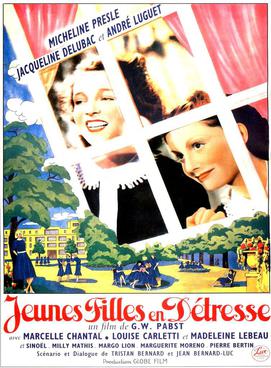
Girls in Distress is a 1939 French drama film directed by G. W. Pabst and starring Marcelle Chantal, Micheline Presle and André Lugue.

The Last Days of Pompeii (1950) is a black and white French-Italian historical drama, directed by Marcel L'Herbier "in collaboration with" Paolo Moffa, who was also the director of production. It was adapted from Edward Bulwer-Lytton's novel The Last Days of Pompeii. The film has also been known as Sins of Pompeii.
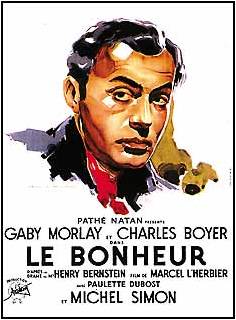
Le Bonheur ("Happiness") is a 1934 French comedy-drama film directed by Marcel L'Herbier. It was adapted from Henri Bernstein's play Le Bonheur, which Bernstein had staged in Paris in March 1933 with Charles Boyer and Michel Simon in leading roles; Boyer and Simon took the same parts in the film.

Feu Mathias Pascal is a 1925 French silent film written and directed by Marcel L'Herbier. It was the first film adaptation of Luigi Pirandello's novel Il fu Mattia Pascal.
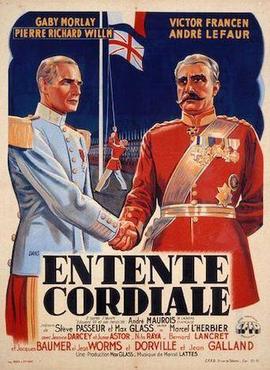
Entente cordiale is a 1939 French drama film directed by Marcel L'Herbier and starring Gaby Morlay, Victor Francen and Pierre Richard-Willm. The film depicts events between the Fashoda crisis in 1898 and the 1904 signing of the Entente Cordiale creating an alliance between Britain and France and ending their historic rivalry. It was based on the book King Edward VII and His Times by André Maurois. It was made with an eye to its propaganda value, following the Munich Agreement of September 1938 and in anticipation of the outbreak of a Second World War which would test the bonds between Britain and France in a conflict with Nazi Germany.

La Comédie du bonheur is a French-Italian film directed by Marcel L'Herbier as a dual-language production. It was filmed in Rome in the early months of 1940, but after Italy joined World War II on the side of Germany, the French and Italian versions of the film were completed separately. The Italian version was released in December 1940 under the title Ecco la felicità!. The French version was released in July 1942.
La Vie de bohème is a French-Italian drama film directed by Marcel L'Herbier. It is based on Scènes de la vie de bohème (1851) by Henri Murger and includes music from Giacomo Puccini's opera as accompaniment. The set designs were created by Georges Wakhévitch. It was filmed during the winter of 1942–43 at the Victorine Studios in Nice. However it was not released until January 1945, after the liberation of France.
La Femme d'une nuit is a 1931 French drama film directed by Marcel L'Herbier. It was made simultaneously with Italian and German versions of the same story, which were however not only in different languages but in different genres.
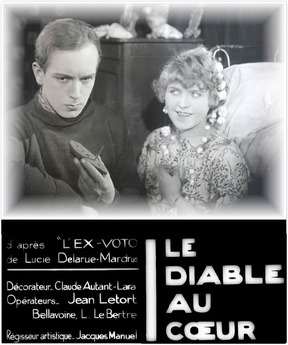
Little Devil-May-Care is a 1928 French-British silent drama film directed by Marcel L'Herbier and starring Betty Balfour, Jaque Catelain and Roger Karl.
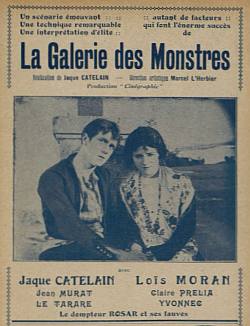
La Galerie des monstres is a 1924 French drama film directed by Jaque Catelain, set against the background of a circus in Spain. It was produced by Cinégraphic, the production company of Marcel L'Herbier.

Veille d'armes is a 1935 French drama film directed by Marcel L'Herbier and starring Annabella and Victor Francen.
















